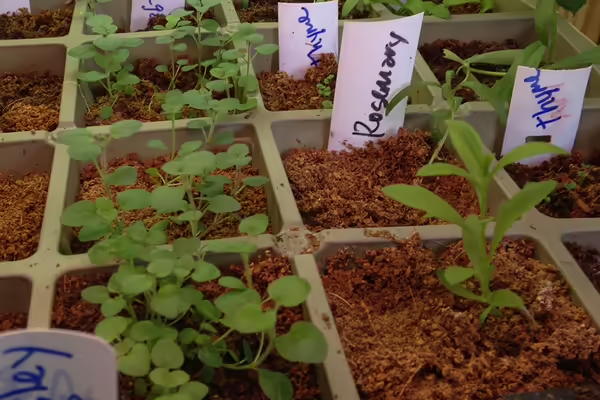
URBANA, Ill. – Herbs are a favorite in most gardens, but transplants can be expensive. As an economical alternative, consider starting seeds indoors in early spring as warmer weather approaches.
Herbs can be started in March and be ready for transplanting into the garden in May, depending on the region of Illinois. Refer to the Illinois State Water Survey for a specific region's average frost-free dates.
Thyme, rosemary, basil, sage, chives, and tarragon are great choices to start indoors. The seeds are very fine and take a fair amount of time to germinate. Oregano started by seed may not be true to the type of seed planted, and flavor will vary.
“Experts recommend propagating strong-flavored plants by root division or cuttings to ensure the best flavor,” Kreith says.
To start herb seeds indoors, use a soil-less seed-starting mix that is peat or coir-based, along with a 4-inch-deep container that provides drainage. Most brand-name soil-less mixes work well for seed starting. Pre-moisten the mix with water until it reaches the consistency of a wrung-out sponge. Fill a container or seed-starting flat with the moist mix leaving about ¼ inch of space at the top.
Prepare the seeding area. Sort various seeds and label containers with the herb name and planting date.
Plant at least five seeds. Also, known as a pinch, of one herb variety per container or cell and lightly cover it with moist mix. “As a general rule, plant a seed two times its thickness under the soil,” suggests Kreith.
Keep seeds moist during the germination period. “After planting, one technique is to cover the flat or container with a clear plastic bag,” says Kreith. The plastic helps hold in heat and aids in providing consistent moisture. “However, be sure to monitor the growing media for mold growth.”
Keep an eye out for mold. If mold appears, make a hole or open a corner of the bag or remove it completely to improve air circulation. Supplemental moisture can also be provided by using a spray bottle. Additionally, the bag should be removed once the seeds germinate in 10 to 14 days. The use of a heat mat will speed up the germination rate.
Thin out overgrown seedlings. As plants become overgrown, seedlings can be thinned out to one plant per pot. Select the strongest and most compact.
The sown containers or flats need about six hours of sunlight per day. A window with either a western or southern exposure will work well at the beginning, but over time the herb seedlings will require more direct and intense lighting. Using supplemental grow lights or fluorescent lighting has proven to work better than natural sunlight.
“If using fluorescent lights, keep them on for a minimum of 10 hours per day and place them as close to the seedlings as possible, adjusting the height as seedlings grow taller,” says Kreith.
Monitor the seeds and seedlings daily as the transplants mature. Be on the lookout for insects, rot, and extremely dry soil.
The seeds and seedlings should only need a light sprinkle of water about twice per week, depending on the size of the pot along with temperature and humidity levels. A good practice is to allow the planting media to dry out a little before watering again. Overwatering can lead to diseases such as damping-off, a common soil-borne fungal disease that ultimately kills young seedlings. Constant moisture can also attract fungus gnats.
“As seedlings mature, some maintenance will be needed,” says Kreith. If seedlings become overgrown, they can be transplanted into a larger cell or a bigger container. If they become leggy, they may not be getting enough light. “Be sure fluorescent lights are placed close enough to the plants, no more than 4 inches away,” says Kreith. “Lights can also be increased to up to 16 hours per day.”
Once seedlings reach six to eight weeks old, pinch back the top leaves to help the plants become bushier. Most herb seedlings should be ready to transplant outdoors in about 10 weeks.
“Help plants harden off or become acclimated to outside conditions by placing them outdoors on mild days and bringing them back inside every night. Keep plants out direct sunlight initially and continue the process for five to seven days,” recommends Kreith.
Once plants are hardened off, they can be transplanted safely into the garden.
While transplanting the seedlings, consider sowing some seeds directly in the ground. Herbs that do well by direct sowing include cilantro, arugula, and basil. Direct-seeding cilantro and arugula, both cool-weather herbs, in early spring provides a bountiful leafy harvest from mid-spring to mid-summer. Warm-loving herbs like basil can also be directly sown after the danger of frost has passed.
For the best flavor, harvest herbs just before they flower. Visit University of Illinois Extension's herbs site to learn more details about specific herbs, their growing requirements, and harvesting and storing methods.
Source/Writer: Nancy Kreith, Horticulture educator, Illinois Extension
Illinois Extension leads public outreach for University of Illinois by translating research into action plans that allow Illinois families, businesses, and community leaders to solve problems, make informed decisions, and adapt to changes and opportunities. Illinois Extension is part of the University of Illinois Urbana-Champaign College of Agricultural, Consumer and Environmental Sciences.